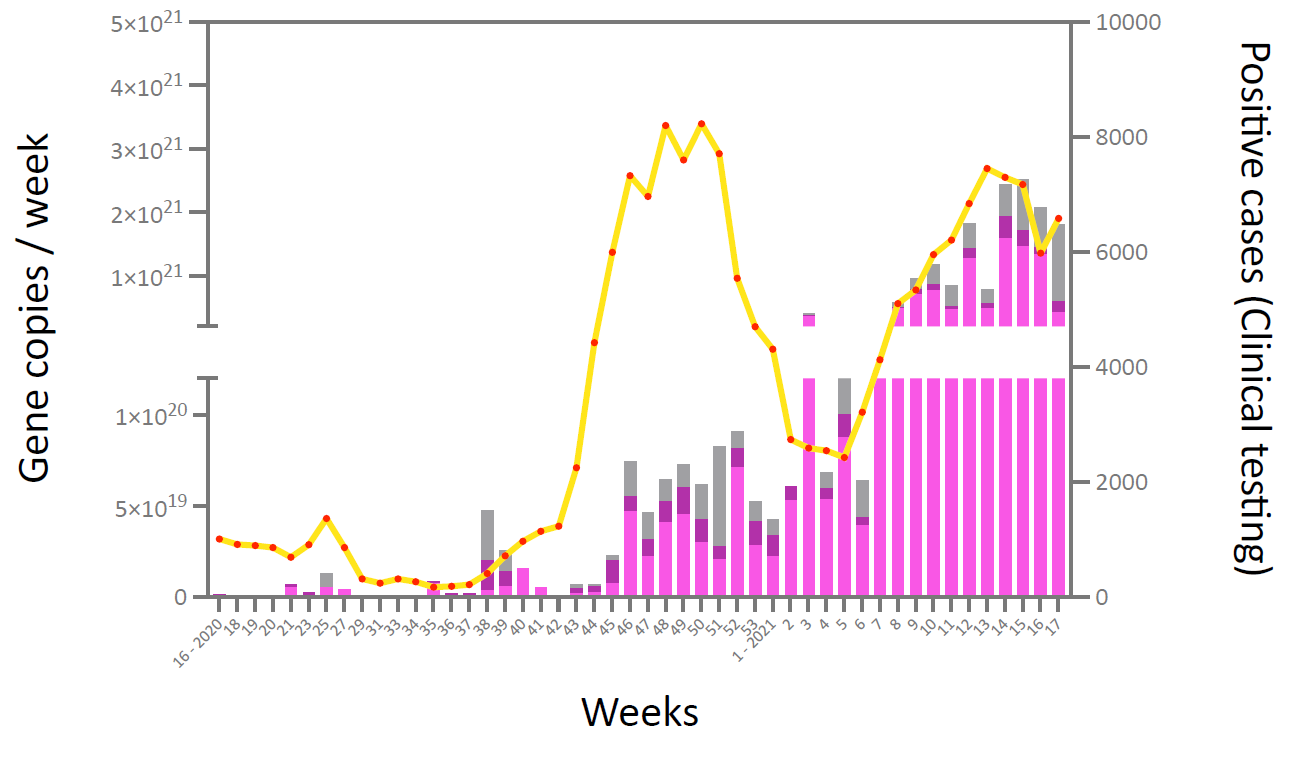7 May - Summary of preliminary results from wastewater analysis for tracing SARS-CoV-2
Stockholm region, May 7, 2021
Preliminary Results from SARS-CoV-2 monitoring in Stockholm Region
The RNA signal detected in the wastewater analyses reflects the amount of virus excreted from infected persons within the catchment area, and may thus be used as an indicator when assessing the trend of the COVID-19 pandemic among the population. The analysis results have been converted into gene copy numbers.


Update Summary
We note an increasing trend during the spring with a current peak at week 14-15. Statistical analysis confirmed a significant correlation (p<0,0001) between wastewater data and case numbers in 2021. The levels of genetic material detected are much higher than during the second wave. The high levels during spring are hypothesized to be due to the British variant which according to a British study sheds higher viral loads.
Read the full British study here.
After our release in February, we have worked on the normalisation method. In last releases, we included normalised by flow-rate only, which does not adjust for factors such as degradation of viral RNA or presence of inhibitors in wastewater. Current normalization includes Pepper Mild Mottle Virus, which is a plant pathogen (RNA virus) that exists in municipal wastewater.
Background and method
Sampling of wastewater has been done since mid-April 2020 at Bromma, Henriksdal, and Käppala wastewater treatment plants (WWTP). These treatment plants receive wastewater from a population of approximately 360,000; 860,000 and 500,000, respectively.
The sampling at Henriksdal and Bromma started in week no. 16 (13 April) and the Käppala sampling started in week no. 18, following a sampling protocol developed by KTH. The flow-proportional pooled samples were taken bi-weekly until end of July. From week no.35 the sampling was done every week. After concentration, filtering and preparation, the samples have been analyzed using qPCR technique for genetic material (RNA) belonging to the virus SARS-CoV-2, known to cause the COVID-19 pandemic.
When analyses have not been possible immediately, raw wastewater has been frozen at –20 degrees, and concentrated wastewater or purified RNA stored at -80 C, until the next analysis step has been carried out.
During June and July, KTH researchers have compared four different concentration methods, two of them are commonly used internationally and the other two were modified methods adapted by the KTH team. The sensitivity of two ultrafiltration-based methods and two adsorption and extraction-based methods were compared for the SARS-CoV-2 as well as for two reference viruses. Our investigation concluded that the double ultrafiltration method adapted by KTH has a significantly higher efficiency compared to single filtration and adsorption methods. The scientific article has been published in Science of Total Environment, an internationally leading scientific journal.
Read the full Science of Total Environment article here .
Normalization of values include both adjustment for flowrate and (from week 5 in 2021) for Pepper Mild Mottle Virus, which is a plant pathogen (RNA virus) that exists in municipal wastewater.
NB. Water and wastewater are not known to be important pathways for transmission of the virus. We have not detected any virus in treated outgoing water and the tracing of SARS-CoV-2 in wastewater should not cause any need for additional precautions for water consumers.
We are grateful for the collaboration with Stockholm Vatten och Avfall AB, Käppalaförbundet, Stockholm Region and the financial support from Region Stockholm and Knut and Alice Wallenbergstiftelsen.
Zeynep Cetecioglu Gurol, Associate Professor
Cecilia Williams, Professor
KTH Royal Institute of Technology
